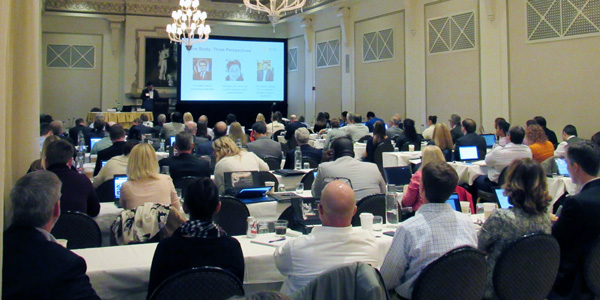By Amanda Durish Cook
CHICAGO — State regulators, their staff and utility executives proved reluctant to be pinned down on predictions about the future of the grid during a spirited question-and-answer session at the annual meeting of the Organization of MISO States (OMS) last week.
Tanuj Deora, chief content officer of clean energy facilitator Smart Electric Power Alliance, posed a series of questions to scrutinize attendees’ core assumptions about the power grid during the Oct. 27 meeting.
“We have an agreement that the power grid is the foundation of our modern civilization, yes?” he asked the audience rhetorically. “Well, there are a number of folks pushing back at that.”
Deora said he’s encountered people who are convinced that the power grid will become a stranded asset. Just a smattering of hands went up in the audience when he asked if any of them believed that people would altogether defect from the grid in the future.
A Future of Low Load Growth
Deora pointed out that recent trends demonstrate that economic growth no longer drives power consumption. “I think most people are planning on a world where we don’t have a lot of load growth,” he said.
Some in the audience noted that electricity demand could spike over the next five to 10 years as more consumers adopt electric vehicles, similar to past spikes when refrigerators and air conditioning started to become commonplace. Deora also pointed out that electricity could increasingly displace natural gas for water and space heating as gas suppliers realize that may be more feasible to meet state emission-reduction targets.
Other audience members noted that if President Trump succeeds in a reviving American manufacturing, companies won’t return to now-vacant energy-devouring factories, but instead design energy-efficient spaces.
Wisconsin Public Service Commission staffer Randy Pilo added that, after multiple years of growth, a recession will loom sooner or later.
A Gray Area
Deora was met with no audience agreement when asked if regulators should continue to plan the grid on the assumption that generation should follow load with no reserve inventory.
“That is a sea change, because, gosh, the [Department of Energy] believes this with their measure of resiliency,” Deora said. He added that he believes the U.S. is on the verge of a “demand response renaissance.”
At least half of the audience agreed that economies of scale still favor central station generation, but generally hesitated when Deora asked whether that supply is best provided through the usual baseload, mid-priced peaker model.
“Come on, this was the first thing I learned as an intern,” Deora said, lightheartedly goading the audience.
Multiple audience members called out: “You can’t choose!” and “It’s gray area!”
“That worked really well when you could build a baseload plant and get energy value. … It’s turned on its head,” said Bruce Campbell, director of regulatory affairs at CPower Energy Management. He said once natural gas prices eventually rise, developers will migrate to yet another fuel type.
Deora ventured that it may be time to reconsider the economic model for power. “Usually when I bring up at conferences that we might need a rethink of power economics, the audience shudders and tells me it’s not time,” he said.
‘Sleepy Backwater’
Deora said that while some utilities are still focused on being a strict wires-only owner or operator, more are exploring how to optimize a distribution system platform or interconnect distributed energy resources — and are even open to owning their own portfolio of distributed resources.
Charles Goldman, a strategic adviser with the Lawrence Berkeley National Laboratory, said past predictions of the adoption of photovoltaic DER have proven too conservative. He said in his state of California, distributed solar is in clustered hot valley areas, wealthy coastal communities and tech-friendly Silicon Valley. Rooftop solar has significantly shifted the noon to 6 p.m. load curve.
“It’s all happened in the last four to seven years,” Goldman said.
“I realize in the Midwest, this is not a topical, front burner issue,” he said, but he noted that Minnesota is considering requiring its utilities to file distribution system plans, including DER forecasting.
“Distribution planning has been the sleepy backwater,” Goldman said.
He admitted that RTOs will have more difficulties forecasting and modeling future distributed resources than single-state ISOs.
Outgoing OMS President and Indiana Utility Regulatory Commissioner Angela Weber said regulators and OMS are uniquely positioned to steer the industry in rules surrounding DER.
“It’s the first time in OMS that I see the states leading on an issue.”






